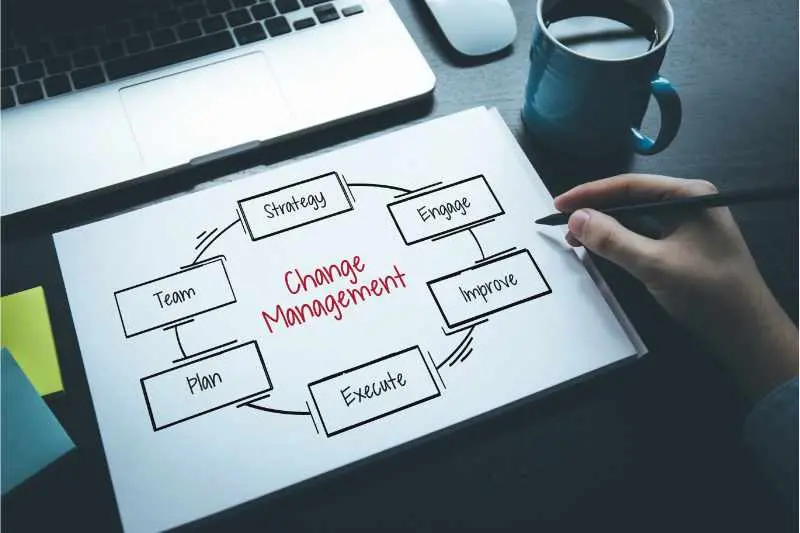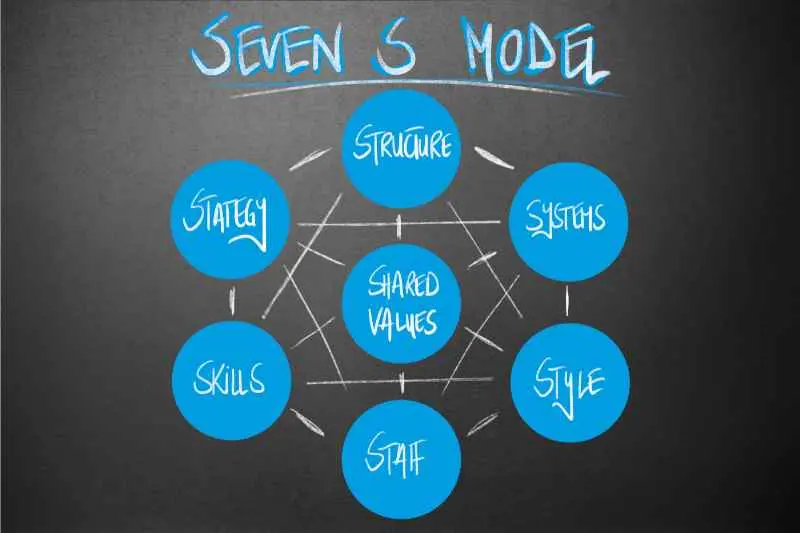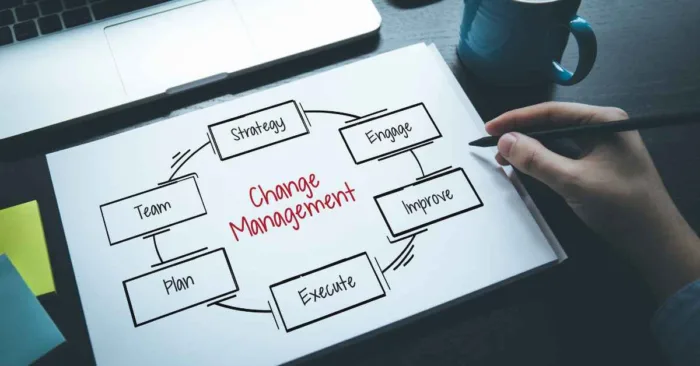Key takeaways
- The change management process involves an organized strategy to transition your workplace through big changes concerning technology, vision, and strategy.
- A change manager plans, implements, and maintains change.
- There are numerous types of change management models, but the most commonly used include the ADKAR model and the 7-S model.
- Tips for managing change management include making a checklist, starting small, and maintaining key performance indicators.

The workplace is constantly evolving. So, the future of work brings a lot of uncertainty and change. Implementing change with a change management model can promote successful organizational change for your office. However, knowing how to manage change effectively is the tricky part.
First, we’ll review the importance of change management and how it works. Next, we’ll review the types of strategies involved with managing change. Finally, we’ll provide tips for organizational change.
This post covers:
- What is change management?
- What does a change manager do?
- The types of change management models
- 3 tips for a successful change management strategy
What is change management?
Change management is the internal process of introducing new policies, company culture, organizational change, technologies, workflows, and automation to your office environment. Your goal is to oversee your employees through this possibly turbulent time to ensure that your team’s work output will achieve success. Change management always tends to follow a structured approach.
The change management process involves three key phases/components:
- Planning. Before implementing new changes to the workplace, you need to prepare your employees. In addition to reviewing the upcoming changes, this phase can involve new training and educational opportunities.
- Utilizing. Conducting the change process is a change manager’s biggest responsibility.
- Adapting. The successful implementation of changes never ends. As the workplace and technologies change, you’ll be forced to continuously adapt. The workplace can’t grow without you.
One of the best change management examples is how a significant percentage of employees are splitting their time working from home and within the office, thanks to a trendy hybrid model. The daily operations of most workplaces must adapt to a work-from-home policy. A change manager will be sure to maintain the status quo while this implementation process continues.
Another change management example is when new project teams are created in the workplace with a specific strategic vision, such as short-term wins over long-term progress. Creating a template and plan for employees to follow during this overhaul of their workflow is essential to meeting your organization’s new goals.
What does a change manager do?
A change manager is a specific role that oversees change management strategies in the commercial office space.
A successful change manager will:
- Increase employee morale.
- Implement the change requested by managers and executives.
- Propose workplace changes.
- Lead workplace changes.
- Sustain the change that is implemented by making necessary adjustments.
The most difficult challenges a change manager will face include:
- Overcoming resistance. Many employees, albeit unintentionally, will resist change. Human beings are creatures of comfort. When we get comfortable with our daily schedule and workflow, we don’t want that to change. A good change manager will have empathy for this resistance and will work to show employees the benefits of said change both for the employee as an individual and for the organization as a whole.
- Adopting new technology. No matter how well trained, no change manager will be an expert at new technology from the get-go. Some technology for the workplace, such as proptech and access control systems, is intuitive to use and implement. Other technology, such as computer software, is much trickier.
- Effective communication. Properly explaining the nature of the changes taking place at the workplace can be tricky. Depending on the severity of the changes, a change manager will have to rely on an organized presentation in order to properly inform and educate employees.
Change management courses
Often, a person in this role has a change management certification or degree that includes specialized training. These courses are not to be taken lightly and can take up to several months of training.
Some of the best change management certification courses are:
- Prosci. This is a prestigious online chain management company that founded the popular ADKAR model (which we will review in the next section.) This level of training will prepare you for any company. They offer both in-person and virtual training.
- The Certified Change Management Professional (CCMP). This course is highly reviewed and is internationally recognized. It’s best used for big international companies.
- eCornell change management certification. This institution offers a dynamic online course that also focuses on leadership in addition to implementing change.
Learn everything you need to know about access control:
Change management tools
In addition to certification courses, there are a number of tools that a change manager can use for effective change management and transformational change in the workplace. The best change management tool will depend on your unique company, your specific industry, and the nature of changes that you expect to face.
Three of the best change management tools are:
- Rocket Aldon. This organizational and tracking software can be accessed by multiple managers at once. It offers a workflow that automates the entire change management process for all types of employees at your company.
- Howspace. This is an AI tool that allows employees to communicate and collaborate on one single platform. AI guides employees through new learning processes and strategies within your organization. The AI in this software analyzes where your employees’ understanding and comfort with certain changes stand so that you can make informed decisions throughout the rest of the change management process.
- Scribe. This software helps your employees stay organized across multiple teams, offices, and other workspaces. It allows for easy collaboration and documentation of current and upcoming changes in the workplace so that employees can remain informed no matter where they are.
The types of change management models
Many different types of change management models and acronyms have been created over the years. Despite the age of some of them, they are all still surprisingly relevant. This is because the following models focus less on the specifics of the change in question and more so on the nature of change and how it relates to your employees.
One of the most popular change management models is the ADKAR model.
The five stages of ADKAR are:
- Awareness of the change needed.
- Desire to engage and work with the change.
- Knowledge of the effects of the change and how to implement it.
- Ability to implement change.
- Reinforcement to maintain the intended change.
Another popular model is McKinsey’s 7-S model.
The seven S-words (in no particular order) that you need to keep in mind when implementing change management are:
- Staff. Your employees’ well-being.
- Skills. Your employees’ current abilities to handle change.
- Strategy. How you will implement change.
- Shared value. The benefits of change.
- Systems. What will be changed.
- Structure. The result of the change and what it means for the workplace.
- Style. Knowing how changes will clash with your employees’ abilities.

3 tips for a successful change management strategy
With everything we’ve covered about change management so far, it’s okay to feel lost.. We’ve provided a few tips that you should always follow when promoting change initiatives in the workplace.
Three ways to achieve your desired outcome with change management are:
- Start off with small steps
- Create a change management checklist
- Know your key performance indicators
1. Start off with small steps
You should never implement the biggest changes first in the workplace. Starting small is best. Introduce one component, such as a new software, to the employees first. Once they have an understanding of said change, then you can move on to the next implementation. Sometimes, you don’t have the luxury of breaking workplace changes down into bite-sized pieces.
In this case, you can still give employees a grace period to get used to new organizational changes. This perceived lower period of productivity is sometimes necessary in order to achieve greater workplace productivity later on.
2. Create a change management checklist
Staying organized is key, and one of the best ways to stay organized is to always create a checklist, no matter the occasion.
Your change management checklist should include:
- The major changes occurring
- The employees or project teams that will be affected by change the most
- Your strategies for implementing the changes
- Goals and key performance indicators once changes are applied
3. Know your key performance indicators
Referring back to your change management checklist, you’ll have key performance indicators you’ll want to look out for when implementing change.
If your employees are not hitting your key performance indicators, then you might need to reaccess whether:
- The new changes are working, or if they are necessary.
- New educational courses and lessons are required so that employees know how to utilize the new workplace changes.
Remember, it’s important to set multiple key performance indicators that have realistic expectations. Performance is meant to gradually increase, after all, and change can be difficult for employees to adapt to.







